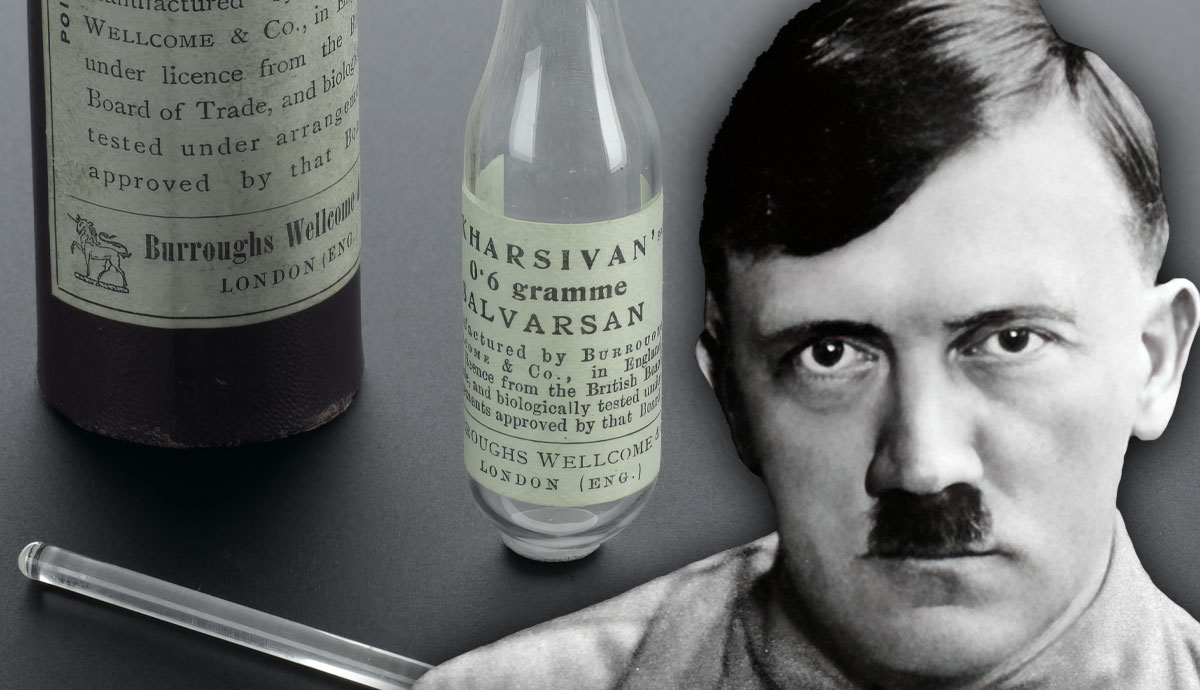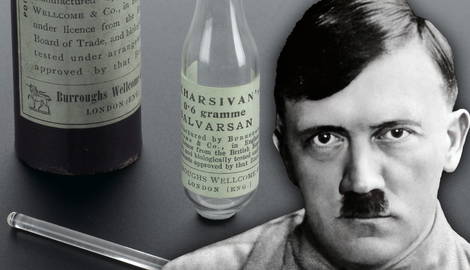
From his physical issues to his psychology, the health of Adolf Hitler is a topic that has been debated by academics since his death in 1945. Indeed, it was discussed by non-academics even when he was alive.
In his final years as Führer of the Third Reich, it was almost impossible to hide his ailments from everyone. It was clear to many that he underwent severe mental stress and psychotic episodes. Those who spent time with him, his closest generals, would bear the brunt of his breaks from reality and his epic temper.
His mental state was not just a psychological disorder, however. It was exacerbated or even caused by concoctions of drugs and potions that were given to him by his personal doctor, Theodor Morell.
1. Hitler Suffered Psychological Trauma as a Child

Adolf was one of six children of Klara and Alois Hitler. Four of the children died in infancy or at a young age. Adolf’s younger brother, Edmund, died from measles at the age of five, leaving Adolf with grief.
Adolf had wanted to become an artist from a young age. Alois, however, pushed for his son to enter the civil service like him. Adolf was sent to a school that did not foster his creativity, and as a result, the young Adolf rebelled, arguing with his teachers and purposefully achieving poor grades. This earned him the anger of his father, and Adolf would receive regular beatings.
2. He Was Wounded in the First World War

Adolf Hitler served with distinction during the First World War, winning two Iron Crosses for his efforts. He was also wounded twice. At the Battle of the Somme in 1916, an artillery shell caused a serious injury in his left thigh, and he was evacuated, spending several months in recovery.
In 1918, he was blinded by a mustard gas attack and was again sent to hospital. While there, the war ended.
3. Hitler was a Hypochondriac

With his mental state exacerbated by the drugs he was taking later in life, Hitler was terrified of cancer. His mother, Klara, had died from cancer (and from the side effects of the cancer treatment) when she was just 47 years old. As a result, Hitler was not only scared of cancer but had premonitions of an early death.
His premonitions would come true, but it had nothing to do with cancer.
4. Hitler’s Doctor Had a Chequered Reputation

With his unconventional methods and treatments, Doctor Theodor Morell was discovered by Adolf Hitler in 1936 after he was recommended to the Führer by Hitler’s personal photographer, Heinrich Hoffmann. Morell won Hitler’s approval in 1936 when the doctor cured him of stomach cramps and, soon after, a rash that he developed on his leg.
Hitler recommended Morell to his inner circle, but they were not impressed by the doctor. Both Heinrich Himmler and Hermann Goering considered Morell to be a charlatan, while Albert Speer thought of him as an opportunist who was careless and lazy in his duties as a medical professional.
When Hitler complained of feeling groggy in the morning, Morell would administer an injection of water mixed with a substance in a gold foil packet, which Morell called “Vitamultin.” When Hitler gave Himmler one of these packets, Himmler had one of his SS doctors analyze the contents. They were found to contain methamphetamines.
When Hitler developed jaundice in 1944 after an assassination attempt, an ear, nose, and throat specialist, Doctor Giesing, examined Hitler and found that Morell had Hitler taking “Dr. Koester’s Anti-Gas Pills” several times a day. Giesing dosed himself with the pills and discovered their harmful effects. They contained strychnine and belladonna. The strychnine was the cause of the jaundice.
Hitler’s entourage also viewed Morell in a poor light. They complained about his crude table manners and his shoddy hygiene.
Morell survived the war and was not charged with any crime. Morbidly obese and in a state of extremely bad hygiene, he died on May 26, 1948, at the age of 61.
5. Hitler Had Parkinson’s

In 1940, Hitler first became aware of a tremor in his left hand. He hid his ailment by hiding his left hand in his pocket. By 1942, at the age of 53, it was clear to Hitler’s close associates that the Führer had a tremor. Nobody mentioned it, even in their memoirs, as it was a secret that had to be closely guarded so as not to allow the public to find out, lest it be associated with alcoholism or senility.
Newsreels from 1945, however, have shown in retrospect that Hitler had Parkinson’s. He showed all the typical symptoms in his posture and his movements. He held himself in a stooped position, with his left arm stiff. He walked with shuffling steps and had limited facial expression. Albert Speer wrote in his memoirs that in 1944, Hitler’s Parkinsonism was bilateral and that the tremors had also spread to his right hand.
The first evidence of Hitler’s condition comes from Leni Riefenstahl’s propaganda film Triumph of the Will, which was produced in 1934. Hitler, 45 at the time, displays the characteristics of early Parkinson’s in his left arm.
6. Hitler’s Injuries in the July Plot of 1944

On July 20, 1944, a plot to kill Hitler unfolded. A group of conspirators set a bomb in the Wolfsschanze, Hitler’s headquarters in Poland. The plot failed, along with a subsequent coup attempt.
Although he survived the assassination attempt, Adolf Hitler did not escape completely unscathed. He was one of the 20 people who were injured in the blast, although his injuries were only light in comparison to many others in the room. He suffered two perforated eardrums and conjunctivitis, along with minor burns and around 200 splinters. And his pants were singed.
Of course, the incident didn’t help his mental state, nor did it stop the Soviets from closing in on Berlin.
7. Evidence of Syphilis?

Evidence suggests that Hitler may have contracted syphilis, which resurfaced later in his life. Joseph Kessel writes that in 1942, a certain Doctor Felix Kersten received from Himmler a top-secret 26-page medical report of Hitler. The report claimed Hitler had contracted syphilis at the age of 20 but was cured of the disease at the time. Symptoms, however, resurfaced in 1937, suggesting that the disease had not been completely dealt with.
Doctor Theodor Morell did treat Hitler with medication such as Salvarsan and iodide salts, which, at the time, were used to treat syphilis. It is alleged that Hitler had a severe fear of venereal diseases, which may have been a result of his contracting one in his youth.
8. It’s Commonly Believed Hitler Had Only One Testicle

A myth since the Second World War, Hitler was alleged to have had monorchism – the condition of having only one testicle. During the war, British troops often sang a marching song called “Hitler Has Only Got One Ball.” The lyrics cast doubt on the masculinity of all the top Nazi leaders. This is probably where the legend started.
Hitler has only got one ball,
Göring has two but very small,
Himmler is rather sim’lar,
But poor old Goebbels has no balls at all!
In 1967, Soviet doctor Lev Bezymensky stated that he had been involved in the autopsy on Hitler’s body and that the German leader had only one testicle. He later confessed that this claim was a fabrication.
In 2008, a British newspaper alleged that the doctor who had tended to Hitler’s wounds in 1916 had stated that Hitler lost a testicle as a result of his injuries. He told his story to a priest who wrote down the details. Whether this story is true or not is a subject of debate. It seems plausible that the story was invented to give credence to the song sung by British troops.
If Hitler had only one testicle, it would have certainly been the result of an injury. Hitler’s childhood doctor, Eduard Bloch, claimed that as a child, Hitler was fully intact.
Adolf Hitler was examined many times throughout his military and political career, and there was absolutely no mention in the records of him having only one testicle.

Hitler had a troubled history with his health. It’s difficult to say for certain, but it’s certainly plausible, and even likely, that his health was worsened by the strange concoctions of medication his doctor administered.
In the last few years of his life, his physical and mental state plummeted drastically, leading to questionable decisions that certainly sped up Germany’s final defeat.










